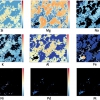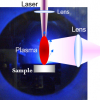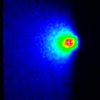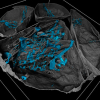Javier Moros, Juan Antonio Lorenzo, Patricia Lucena, Luciano Miguel Tobaria and José Javier Laserna*
Department of Analytical Chemistry, Faculty of Sciences, University of Málaga, E-29071 Málaga, Spain
Introduction
The problem of detecting, recognising and identifying explosives at significant standoff distances has proved one of the most difficult—and most important—challenges during recent years, being today, one of the most demanding applications of spectroscopic techniques. The limited number of sophisticated available techniques potentially capable of standoff detection of minimal amounts of explosives is based on laser spectroscopy. Of the recently developed techniques, Raman spectroscopy and laser-induced breakdown spectroscopy (LIBS) are considered significant for their potential for homeland defence applications.1,2 These two techniques both interrogate samples using laser beams, both use spectrographs to disperse the signal over overlapping spectral ranges and both require approximately the same spectral resolution. Additionally, both techniques are very complementary in the data they provide; LIBS yields detailed information on multi-elemental composition, whereas Raman spectroscopy yields information about molecular composition. Thus, LIBS and Raman spectroscopy have several features that make a combined instrument for remote analysis very attractive.3
However, beyond these first quick glances at the two complementary approaches, there are many problems that make it difficult for both techniques to operate in a complementary, simultaneous way, because of constraints imposed by their signal collections. Raman scattering and atomic emission processes take place in temporal windows of different order, Raman signals can be overwhelmed by the background continuum emission from the LIBS plasma, and laser power density (as a function of the area size of the target where laser energy comes into contact with) imposes strict instrumental conditions on the detector as well as for the optical system used for laser focusing.
The concept of extracting information on both spectroscopic phenomena from a sample using a single instrument has been around for a while. Indeed, several papers have been published demonstrating Raman and LIBS sequential data acquisition (that is, refreshing the sample position and modifying the laser pulse energy or the beam focal conditions) but in these situations, Raman and LIBS information may not provide any direct relation as the spectral data do not belong to the same interrogated target area.4
"Sensor fusion" permits the integrated use of the Raman and LIBS spectroscopic techniques for achieving either better performance or reducing the penalties occurring when each sensor is used separately. It may provide an improved solution in terms of required identification confidence, since combining simultaneously collected data from both sensors then a more accurate assessment of the sensed target can be obtained.5
This article presents the first experimental fused sensor development permitting one to obtain standoff, instant, simultaneous, separate Raman spectra and LIBS data from single laser events on the same spots of the target.
Raman-LIBS hybrid sensor system
Figure 1 illustrates the mobile hybrid sensor system used for simultaneous Raman and LIBS spectroscopy based standoff analysis. The radiation source is a Quantel Brilliant Twins Q-switched Nd:YAG laser (10 Hz, 400 mJ pulse–1, @ 532 nm, 5.5 ns pulse width); a 10× large output beam expander (Special Optics, Wharton, NJ, USA) is employed for first expanding and then focusing the beam onto a well-defined distant spot. Both spectroscopic signals are collected using a home-made Cassegrain telescope (167 cm in length and 24 cm in diameter), and the return light is focused onto the tip of a bifurcated optical fibre (600 µm in diameter mounted on a precision linear stage). Fibres are coupled to a pair of identical gated Shamrock sr-303i Czerny–Turner spectrometers, each fitted with an Andor iStar intensified charge-coupled device (CCD) camera as detectors. The Raman spectrometer uses a 300 grooves per mm grating, whereas the LIBS spectrometer uses a 150 grooves per mm grating. A Holographic SuperNotch filter (Kaiser Optical Systems) is placed in front of the fibre to remove the Rayleigh-scattered light at 532 nm. Two pulse and delay generators (Berkeley Nucleonics model 565–4C) are also included to aid in the synchronisation of the experiment. The entire system is mounted on a wheeled, easily transportable cart equipped with levelling feet for guaranteeing system stability once it is located at the desired location. Furthermore, the laser and telescope are also mounted onto a pair of pneumatic levelling isolation mounts to avoid oscillations of both the focusing point on the target and on the light collection point at the optical fibre.

Timing
When simultaneous molecular and multi-elemental analytical information needs to be separately collected a time-resolved study for signal acquisition is the first critical issue. In Raman spectroscopy incident light interaction with the molecule and photon scattering occur almost simultaneously, the Raman phenomenon lifetime remaining within the laser pulse time regime and photons are scattered during the laser pulse width (5.5 ns). Furthermore, Raman scattering competes with molecular fluorescence emission since both phenomena have similar origins, and they must be discriminated by proper timing, thus permitting one to collect only those Raman photons scattered during the laser pulse and rejecting the vast majority of fluorescence.
In contrast, atomic emission that follows laser ablation is a much slower process (heating, vaporisation, atomisation, ionisation and radiative emission must take place) with LIBS spectra being detected once the plasma continuum emission is almost extinguished.
In this sense, since temporal windows in all instances broadly differ, the time-resolved capability offered by gated multi-channel detectors can overcome the problem of phenomena discrimination. Temporal evolution of Raman and LIBS signals (spectra acquisition at different delays—gate delay—from the output signal of the laser to the opening of the camera intensifier tube) are illustrated in Figure 2.

Time-resolved, low-irradiance experiments (Figure 2A) permit one to identify the most appropriate timing parameters to record the Raman spectrum without interference from fluorescence emission, which, as a function of its intensity, can render the acquisition of useful Raman spectra very difficult. Whenever fluorescence is excited, the Raman signature of the material "rides" on top of a broad non-specific baseline and thus, significant growth in the background signal can be observed. Under the operating conditions explored, its presence slightly appears at gate delays longer than a few ns.
However, for simultaneous collection of Raman and LIBS information from the same laser event on the same target spot, timing parameters for Raman signals acquisition must be evaluated under high-irradiance experiments (Figure 2B) that cause laser-induced breakdown to occur. Under this condition bremsstrahlung and unspecific recombination emission take place after plasma formation and the Raman signature again "rides" on top of a broad non-specific highly tilted baseline, which may totally mask the weakest Raman bands at delay times of tens of ns.
Thus Raman acquisition requires a delay time to be set large enough to allow the Raman signal to develop but short enough to avoid masking of the molecular fingerprint by the LIBS background. For optimum LIBS signal collection a gate delay of about 1 µs is required in order to avoid collecting the unspecific background signal, and the LIBS signal must be acquired during just a few µs after its occurrence, see Figure 2C.
Laser power
For all spectroscopic information simultaneously occurring during a single laser event, optimal combination of pulse energy and beam focal conditions resulting in effective excitation of both phenomena must be found. The success in simultaneous information acquisition is linked to the intensity distribution profile of the laser beam. Thus, after the interaction of the laser pulse on the surface of the target, several processes combine, including ablation and laser-induced breakdown in the inner part of the beam, where the irradiance is above the ablation threshold of the material, and molecular scattering occurs in the outer and less intense region of the beam.
Evaluation of the behaviour of LIBS emission lines together with observation of Raman bands for several materials under a wide range of irradiance conditions provides scientists with vital information on optimum energy and spot size for laser focusing.
As an example, Figure 3 shows irradiance effects on dual Raman-LIBS simultaneous signals illustrating the intensity of the most characteristic Raman feature and the most intense emission signal for some representative substances. As shown, a 560 mJ laser pulse focused to a 2.5 mm2 area spot ensures an adequate trade-off, since under these experimental conditions, irradiance is well above the threshold level required for inducing standoff laser-induced breakdown in the different solids tested, whereas the irradiance is low enough to avoid totally masking of the Raman signature of the material.

Signal acquisition
While single-shot LIBS measurements have demonstrated tremendous possibilities for chemical analysis as well as for samples identification, including energetic materials located on a surface at different distances from the instrument, multiple-shots must be accumulated before a useful Raman signal-to-noise ratio (SNR) builds up.
This fact is particularly relevant in simultaneous spectra acquisition because the number of accumulated laser pulses for Raman spectrum collection must be set to a minimum in order to cope with the single-shot capability of LIBS, since the first shot can ablate all or most of the target. As expected, Raman SNR grows with the number of accumulated laser pulses. However, a somewhat different behaviour, due to the distinct degree of compactness of each chemical, their different heterogeneities and the laser ablation that occurs while the Raman spectra are accumulated, can be observed as a function of the compound tested.
While the use of accumulated laser pulses is required for a clear and useful Raman fingerprint, the traditional ensemble-average of spectra resulting from the same number of laser pulses is used for the final multi-elemental LIBS spectrum.
Figure 4 shows raw standoff (20 m) dual Raman-LIBS spectra of several substances simultaneously acquired.

Sensor features
In considering the operating parameters, some features, including target mass ablation rate and spectral variability derived from the use of the sensor, must be considered. Depending on the target, laser-created craters produced on solid surfaces can span the range of several mm3 volumes, evidenced by the broad differences in ablation behaviour as a function of the characteristics and nature of the chemical. In spite of the difference in physicochemical properties, the degree of compactness of the target considered is an important parameter in ensuring a homogeneous ablation rate (with a low variability in attained mass) and compounds with analogous compactness exhibit similar ablation rates in the low hundred µg per shot.
Regarding correlation between ablation rates and Raman and LIBS spectral signals, it must be mentioned that a large ablated mass per pulse does not necessarily result in an increased LIBS signal intensity since most of the material ablated can be ejected from the sample surface in the form of non-emitting particles. On the other hand, Raman intensities do not seem to show an apparent correlation with ablation rates, something that might have been expected because the Raman signals are inferred from the intact, non-ablated section of the target which interacts with the laser beam. Nevertheless, broad differences in the properties and formulations of the explosives compounds prevent definitive conclusions, and it is not possible to extend the aforementioned arguments to all compounds.
However, in general trends, conditions that favour Raman scattering tend to reduce LIBS emission and vice versa.
Conclusions
A novel mobile hybrid sensor system has been developed that is able to simultaneously measure both the Raman spectrum and laser-induced breakdown spectrum for the instant, standoff analysis of explosive materials. This hyphenated spectroscopy approach of Raman-LIBS exploits the energy distribution profile of the laser beam to extract the vibrational fingerprint from the non-ablated section of the interrogated target within the outer part of the laser beam jointly together with the atomic information gained from the ablated mass by the inner part of the laser beam. Under well-defined operating conditions (timing, laser power and acquisition) molecular and multi-elemental spectral information gathered which belongs to the same interrogated area inspected by the same laser event is demonstrated.
Despite this exciting achievement, further evaluations through the implementation of chemometric tools and data fusion strategies for the enhancement of the systematic analysis capabilities of the system to be safely used in the standoff detection of explosives residues left (for example, by human fingerprints) under changing weather conditions (atmospheric temperature, relative humidity, wind etc.) with a reduced spectral variability must be carried out.
References
- J.C. Carter, S.M. Angel, M. Lawrence-Snyder, J. Scaffidi, R.E. Whipple and J.G. Reynolds, Appl. Spectrosc. 59, 769 (2005).https://doi.org/10.1366/0003702054280612
- C. López-Moreno, S. Palanco, J.J. Laserna, F.C. De Lucia, Jr, A.W. Miziolek, J. Rose, R.A. Walters and A. Whitehouse, J. Anal. At. Spectrom. 21, 55 (2006).https://doi.org/10.1039/B508055J
- G. Bazalgette Courrèges-Lacoste, B. Ahlers and F. Rull Pérez, Spectrochim. Acta A 68, 1023 (2007).https://doi.org/10.1016/j.saa.2007.03.026
- S.K. Sharma, A.K. Misra, P.G. Lucey and R.C.F. Lentz, Spectrochim. Acta A 73, 468 (2009).https://doi.org/10.1016/j.saa.2008.08.005
- S.R. Robison, The Infrared & Electro-optical Systems Handbook. Emerging Systems and Technologies, Volume 8. SPIE Optical Engineering Press, Washington (1993).
- J. Moros, J.A. Lorenzo, P. Lucena, L. Miguel Tobaria and J.J. Laserna, Anal. Chem. 82, 1389 (2010).https://doi.org/10.1021/ac902470v








